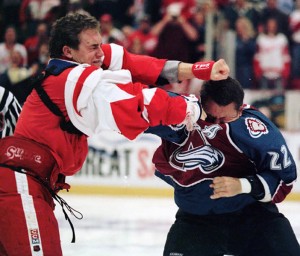To fight, or not to fight


(Left to right) Darren McCarty fights Claude Lemieux after McCarty beat Lemieux to the ice earlier in the 1997 season. (Photo courtesy of The Peterborough Examiner)
When people think of hockey, they think of stereotypes like missing teeth, hard hits, beards and pucks — but it seems most people identify the sport with fighting.
In an unscientific survey conducted for the MediaPlex, 78 per cent of participants said fighting should be allowed whereas 10 per cent believe it should be removed.
The arguments against fighting are usually the potential brain damage that fighting could cause and the possibility of serious or even fatal injuries.
Detroit Red Wings’ legendary tough-man Bob Probert and New York Rangers enforcer Derek Boogaard are examples of fighting’s long-term effect. After long careers of fighting in the NHL, both were diagnosed with Chronic Traumatic Encelopathy, a degenerative brain disease diagnosed in many athletes who suffer repetitive brain trauma.
Over the years there has been controversy over whether fighting should be allowed in hockey. On Dec. 12, 2008, Whitby Dunlops’ Don Sanderson removed his helmet and dropped the gloves in his final fight. Sanderson squared off and after losing his footing fell backwards and cracked his skull on the ice. Sanderson was only 21 and would be the first death recorded in hockey.
After Sanderson’s death, the OHL adopted stricter rules regarding fighting but the NHL has continued with little change.
NHL Commissioner Gary Bettman has been quoted supporting fighting in a 2016 Sports Illustrated interview.
“Statistics will tell you that this is a physical game and fighting isn’t the only issue,” said Bettman. He also mentions the drop in hockey fights over the years.
According to TheHockeyNews.com, in the 2012-2013 NHL season there were an average of 0.96 fighting major penalties per game. In the 2013-2014 season, the average fighting majors dropped to 0.76. Over the years fighting majors have continued to drop and according to NYDailyNews.com, in the 2015-2016 season the average dropped to 0.28.
Fighting in hockey is still controversial and many believe fighting has no use in the sport. Others believe it plays a large role.
“Growing up you see the big hits on TV and fights and it’s a momentum builder for their team,” said William Stadder, a centreman for the Junior C Essex 73’s in the PJHL.
“I’ve been involved with hockey from Hockey Night in Canada to…the Essex 73’s,” said Stadder. “I see it today in my league. A hard shift from your teammates gets the rest of the boys fired up and pushes you to play better.”
One of the most common arguments for hockey fights is that it keeps dirty hits down because those can trigger fights.
“When a teammate gets hit from behind or intentionally injured you should jump to their aid. Sometimes a fight is necessary to send the message,” said Stadder.
Aside from fans supporting fighting as an important role, many believe it is more entertaining.
“If you take fighting out of hockey then it’s like censoring almost. It’s part of the game,” said Hannah Kohut, a student at Humber College currently studying public relations. “I don’t follow [hockey] but I like watching it. I find [fighting] entertaining. It makes hockey, hockey.”
Many people still enjoy the physical and fighting styles of what some call “old-time-hockey.”
Layne Gouin is a former Windsor Spitfire currently spending his time working and playing hockey on the side. Gouin is a fan of the old school style of rough hockey and he has noticed a shift in playing styles over the years.
“[It was] more gritty back then. More fighting and a lot more dump and chase. Nowadays it’s more about puck possession and skill,” said Gouin.
Like Stadder, Gouin notices the importance of both styles.
“I’ve followed hockey my whole life and appreciate the game,” said Gouin. “I like the speed and stick handling more but fighting and grit is great as well.”
The NHL is far from changing the rules of fighting and many believe they never will. As for the injuries, officials are beginning to crack down on stopping fights before they break out.


